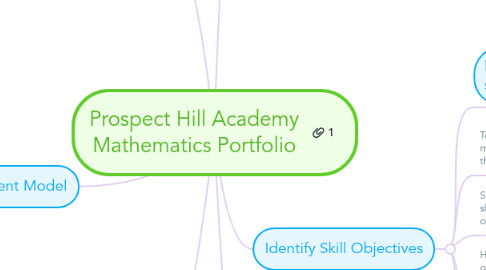
1. Designing Unit Questions
1.1. Many different types, but all require students to describe conceptual understanding.
1.2. To promote deeper exploration of mathematical concepts and ideas.
1.3. Example: What are three different ways of describing the slope of a line, and how are they related?"
2. Portfolio Assessment Model
2.1. Cover and table of contents
2.2. Cover letter - students summarize what they learned during the unit and identify what was new knowledge, what was review, and what questions remain.
2.3. Vocabulary
2.4. Skill descriptions
2.5. Unit questions
2.6. Reflection - Students reflect on their classroom participation, behavior and quality of work. Also identify specific areas for improvement.
3. Assemble Team of Educators
3.1. Work in groups to ease work load and provide support.
3.2. Begin thinking about what skills, vocabulary and concepts are most important for students to learn.
4. Identify Skill Objectives
4.1. Identify critical learning objectives based on school's standards-based curriculum maps
4.1.1. State Standard: 6.GM.4 Find the area of complex shapes composed of polygons by composing or decomposing into simple shapes; apply this technique to solve real-world and other mathematical problems.
4.2. Teams of 2 or more teachers select 3 to 5 of the most important skills for students to master by the end of the unit.
4.3. Sample: "I can identify the area of a complex shape by using the area formulas for simpler objects."
4.4. Have students start skill descriptions in class one day and work on it as part of homework for the next several days
4.5. Skill Description
4.5.1. Skill Title
4.5.2. Skill Description
4.5.3. Examples
4.5.4. Application
4.5.5. Description of the process
5. Select Unit Vocabulary
5.1. Unit specific and frequently occurring mathematical terms are directly taught.
5.2. Examples: solve, function, evaluate, polygon, right triangle, composing, decomposing, rectangle, circle
5.3. Create definition template
5.3.1. State the Term
5.3.2. Mathematical definition of the term as you learned it in class.
5.3.3. Explain the meaning in your own words. You should be able to look at this explanation and understand what the word means even if you have not looked at it in a while.
5.3.4. Show an example of the term and show something that looks like and example but is not. Explain the difference between the two.
5.3.5. Show another way you can think about this term or something that will help you remember the concept. You may want to show a picture, graph or diagram.

